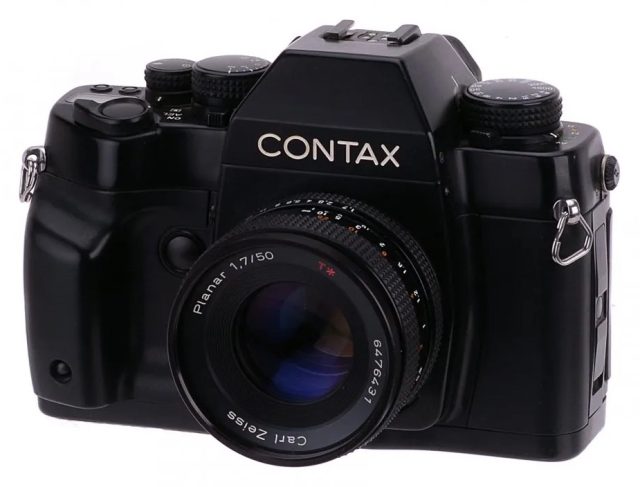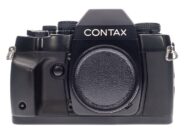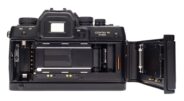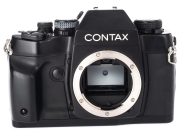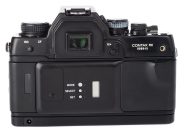Announced
Production status
System
Contax/Yashica system cameras
- Contax 137 MA Quartz
- Contax 137 MD Quartz
- Contax 139 Quartz
- Contax 159 MM
- Contax 167 MT
- Contax Aria
- Contax AX
- Contax Preview
- Contax RTS
- Contax RTS II Quartz
- Contax RTS III
- Contax RX
- Contax RX II
- Contax S2
- Contax S2b
- Contax ST
- Yashica 107 Multi Program
- Yashica 108 Multi Program
- Yashica 109 Multi Program
- Yashica FR
- Yashica FR I
- Yashica FR II
- Yashica FX-1
- Yashica FX-103 Program
- Yashica FX-2
- Yashica FX-3
- Yashica FX-3 Super
- Yashica FX-3 Super 2000
- Yashica FX-70 Quartz
- Yashica FX-D Quartz
Contax RX
35mm MF film SLR camera • Discontinued
Specification
| Format: | |
| 35mm full frame | |
Film type: | 135 cartridge-loaded film |
| Contax/Yashica [45.5mm] | |
| Shutter: | |
Type: | Focal-plane |
Model: | Electronically controlled |
Speeds: | 16 - 1/4000 + B |
| Exposure: | |
Exposure metering: | Through-the-lens (TTL), open-aperture |
Exposure modes: | Programmed Auto |
| Aperture-priority Auto | |
| Shutter-priority Auto | |
| Manual | |
| Physical characteristics: | |
Weight: | 810g |
Dimensions: | 151x104.5x59mm |
Manufacturer description #1
With This Camera We Present, A Machine That Maximizes The Bond Between Artist And Tool.
The CONTAX RX is a remarkable tool that adds useful automation to enhance the photographic experience. The newly developed "Digital Focus Indicator" function uses advanced technology to accomplish this task intuitively. CONTAX decided early-on that Carl Zeiss T* lenses could not be enhanced by adding auto-focus capability. Considerations such as weight and focus accuracy contributed to the decision against auto-focus. As a result, a system was developed that preserves the supreme integrity of the Carl Zeiss T* Lenses.
Technology Is A Tool For Liberating Creativity.
An Innovative New "Digital Focus Indicator (DFI) Function" At CONTAX the over-riding priority continues to be Image Quality. This concern for high quality has lead to the development of a completely new focusing method totally contained in the CONTAX camera body. At times, even professional photographers encounter focusing difficulties that could be eased through a focus assistance device. The Digital Focus Indicator was developed entirely for application in the CONTAX RX to overcome focusing limitations in the human eye. Many focusing systems were evaluated and subsequently rejected. When focusing discrimination was enhanced, operational efficiency was drastically reduced. When indicator stability was achieved focus accuracy declined. The solution.... the CONTAX Digital Focus Indicator (DFI) function. The Digital Focus Indicator shows the true focus point and variance between the focus point and the position under evaluation. CONTAX believes this is the best solution for Carl Zeiss T* lens users.
There are two Focus Indicator Scale Modes on the CONTAX RX, they are:
(1) Focus Scale Indication. This mode is useful for taking general photographs and shows the variance from the true point of focus. It may be set via the green "o" position on the drive mode.
(2) Depth of Focus Scale Indication: This mode indicates the variance from the true focus point as well as the depth of focus which changes with the aperture on the lens. These two measurements are used in combination to graphically show the user whether or not the object is within the depth of focus.
CONTAX provides Highly Durable And Reliable Equipment For Photographers.
The CONTAX RX begins with a copper/silumin alloy die-cast chassis that is high temperature/high pressure steam annealed to eliminate distortion. The CONTAX RX is designed to provide the ultimate in ergonomic design and camera body weight is an important factor affecting the feel of the entire package. The key is to provide enough mass in the camera body to damp out the vibrations induced by the movable mirror and lens mechanisms. The overall design of the CONTAX RX has been calculated using the most advanced CAD simulation available to maximize overall strength durability and ultra-precision over an extended lifetime of extreme usage. The stainless steel mount fastened in place with screws at 6 points fully ensures reinforcement of the lens mount. The top and bottom covers on the CONTAX RX are constructed of brass alloy to protect the inner working mechanisms from impact damage.
Quiet Operation With 1/4000 Second Shutter.
The shutter in the CONTAX RX is a vertical travel unit with a top speed of l/4000 second. This design allows optimum performance with a wide open aperture to exhibit the unique characteristics of the Carl Zeiss T* lens. The high speed shutter is often useful for sports photography.
A Powerful And Ultra-Reliable Drive Mechanism
The CONTAX RX is supplied with a quartz data back which imprints data in the vertical margin between frames. Film advancement is detected by a turning sprocket that precisely positions the film so that the data information is placed between the frames. Three low-noise, high performance DC motors work independently to charge the shutter and move the mirror, advance the film and rewind the film. Reliability and durability are enhanced by reducing the overall complexity of the system. The CONTAX RX uses a "film friendly" spool drive system for film winding.
Light And The Optical Path
An Over-sized Pentaprism For The Ultimate Optical Performance
Regardless of any advancement in electronics, the optical path is of critical importance to the success of any optical system. The pentaprism in the CONTAX RX includes a silver-evaporated reflection surface that insures extremely low flare, and an aberration-free viewing environment. As a result the CONTAX RX viewfinder is superbly clear and bright so that there is little to obscure the photographer's vision
Center-weighted Average Metering
General photography is most appropriate with the center-weighted averaging metering system as found on the CONTAX RX. This system relies on the assumption that the main subject is central to the image field. The center-weighted pattern, as used on the CONTAX RX, has been developed through experience developed over many years. The center-weighted light metering module incorporating an ultra-precise aspheric lens, SPD package and integrated circuit is located behind the pentaprism and above the eye-piece.
Spot Metering
The spot metering system in the CONTAX RX allows a selected small area of the image to be analyzed as a basis for exposure of the entire scene. The spot corresponds to about 5mm central microprism area of the focusing screen.
TTL Direct Flash Metering
A dedicated CONTAX flash may be used on the CONTAX RX in the TTL mode by simply attaching it and setting the flash to TTL. Light reflected from the film plane is measured by the Silicon Photo Diode (SPD) located under the mirror box and fed to the electronic flash control circuit.
High Performance SPD Package & Ultra-Precise Aspherical Lens The latest generation of high performance SPD package is incorporated into the CONTAX RX to provide light metering accuracy. It offers superb performance under various lighting conditions across a wide temperature spectrum as well as high durability. An Ultra-precise aspherical lens covers the SPD to provide maximum coverage and minimal light reading error.
Precision Information Is Preserved In The CONTAX RX Circuitry
Complete Elimination Of Exposure Metering Error
The electronic circuitry in the CONTAX RX is designed with low impedance to reduce the influence of external noise. The SPD and the analog processing system have been integrated into a single custom metering IC that transmits a voltage signal to the Central Processing Unit (CPU) for improved metering accuracy. The ISO film speed, aperture and internal final adjustments are automatically computed and controlled by the CPU. Accordingly, not only are delicate adjustments available, but the circuitry is far less prone to deterioration normally associated with aging thus ensuring long-term stability.
Improved Camera/Flash Communication
The combination of the CONTAX RX and TLA 360 results in improved communication between camera and flash. The ISO and aperture information are held in common. The back panel of the TLA 360 shows the coupled shooting range. Exposure compensation on the camera body causes both camera and flash to respond to the new setting however, exposure compensation on the flash will provide automatic lighting ratios for expressive photography. The charging mechanism on the TLA 360 is activated by pressing the shutter release button on the CONTAX RX camera even while the auto-power-off feature on the TLA 360 is in action. The auto-set features integrate the TLA 360 with the CONTAX RX into one working unit that extends the power of flash photography.
High-Speed CPU And Software For Superb System Control
The CONTAX RX has two high-performance CPUs which control all the camera systems. These CPUs use the most advanced software to assure the best results under various photographic conditions. Additionally, the CPUs in the CONTAX RX can detect and isolate the chattering of the mechanical contacts that detract from the efficiency of other systems.
Manufacturer description #2
Type: Auto-exposure 35mm single-lens reflex camera with focal plane shutter
Picture Size: 24 x 36mm
Lens Mount: Contax/Yashica MM Mount
Shutter: Vertical-travel focal-plane shutter
Shutter Speeds: 16 sec. - 1/4000 sec. at "Av" and "P"; 4 sec. - 1/4000 sec. (setting values) at "Tv"; B, X (1/125 sec.), 4 sec. - 1/4000 sec. on manual
Sync Contacts: Direct X contact (synchronizing speeds 1/125 sec. or slower), provided with sync terminal
Self-timer: Electronic self-timer with a 10-sec. delay
Shutter Release: Electromagnetic release, provided with a special release socket
Focusing System: Manual and auto focus
Exposure Control: 1. Aperture-priority auto exposure. 2. Shutter-speed-priority auto exposure. 3. Programmed auto exposure. 4. Manual exposure. 5. TTL auto flash control. 6. Manual flash control.
Metering System: TTL center-weighted average light metering/spot metering switchover
Metering Range (ISO 100, f/1.4): EV1-20 on center-weighted average light metering, EV5-20 on spot metering
Film Speed Range: ISO 25-5000 for automatic setting with DX film, ISO 6 - 6400 for manual setting
AE Lock: The quantity of light on the image surface is stored in memory
Exposure Compensation: +2EV to -2EV (can be set in 1/3-step increments)
A.B.C. Mode: +/-0.5EV to +/-1.0EV exposure compensating values with A.B.C. lever
Flash Light Control: TTL direct flash control
Flash Synchronization: In combination with dedicated flash, the shutter speed is automatically set when the flash is fully charged
Flash automatic setting: Possible by being combined with our flash with function flash auto setting festure
Second Curtain Synchronization: Possible with Contax flash having a second curtain synchronization capability
Focus Indicator: TTL phase difference detection system. Measurable: EV2 to 20 luminosity range. Displayed by the digital focus indicator in the viewfinder
Viewfinder: Eye-level type using the pentaprism (Long eye point type). Field-of-view 95%, magnification 0.8X (with 50mm lens at infinity and -1D diop. eyepiece)
Diopter Adjustment: Built-in diopter adjuster, correctable range +1D to -3D
Focusing Screen: Horizontal split-image/microprism type (FW-1) (standard), interchangeable screens available (FW type)
Display in Viewfinder: Digital focus indicator, shutter speed, aperture, exposure mark, A.B.C. mode, exposure compensation, metering mark, exposure counter, flash mark
Display Panel: Film counter/film speed/remaining time on self-timer/elapsed time on bulb exposure, multiple exposure mark, custom function mark and battery warning mark
Film Loading: Auto loading, automatic film positioning to "01" on counter
Film Advance: Automatic winding with built-in motor
Film Rewinding: Automatic rewinding with built-in motor, automatic stop after rewinding is completed, mid-roll rewinding possible
Drive Modes: Single-frame shooting, continuous shooting, self-timer shooting, and multiple exposure shooting
Winding Speed: Up to 3 frames/sec. on continuous shooting ("C" mode) (with a new battery, at ordinary temperature, as tested according to Contax testing standard)
Film Counter: On display panel and viewfinder, both automatically resetting, additive type
Accessory Shoe: Direct X-contact hot-shoe (provided with TLA flash contact)
Custom functions: Viewfinder indicator selection (metering-weighted indication/exposure-weighted indication/no indication); Green position mode setting; AE lock operation (AE lock is activated by pressing exposure check button); Multiple exposure operation (normal/continuous); A.B.C exposure order selection (standard -> over -> under / over -> standard -> under); Stop-down button operation (activate only when being pressed / push ON-push OFF system); Film end rewinding (completely rewound/film end left unwound); Film rewinding mode selection (rewound when operating rewinding lever/ automatically rewound after the last frame is completed)
Camera Back: Can be opened by camera back opening lever; detachable; provided with data back and film check window
Data back: Built-in quartz clock (auto calendar), dates are printed in a space between frames (outside the picture area), printable data... year-month-day, day-hour-minute, no-printing, month-day-year, day-month-year
Power Source: One 6V lithium battery (2CR5), one lithium data-back battery (CR2025) in camera back
Battery Check: Automatic check, battery warning mark in display panel
Battery Capacity: About 150 rolls of 24-exposure film (with a new lithium battery (2CR5), at ordinary temperature, as tested according to Contax testing standard)
Others: Aperture stop-down button, External Power socket
***
This camera is a multi-mode auto-exposure single-lens-reflex camera with various exposure control features such as aperture-priority auto exposure, shutter-speed-priority auto exposure, programmed auto exposure. Its new digital focus indicator in the viewfinder allows you to easily focus the lens.
In combination with the CONTAX TLA Flash System with automatic flash setting feature, the film speed and aperture set in the camera are automatically set to the flash unit.
